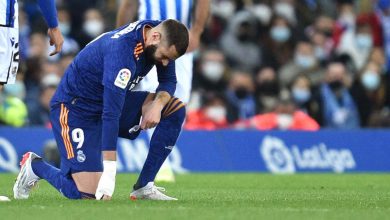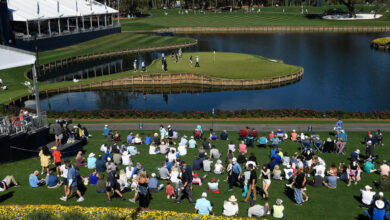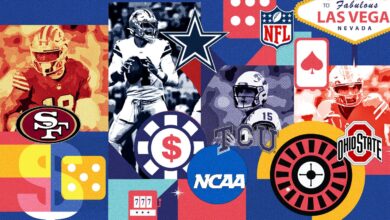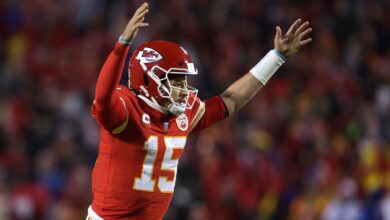Miguel Cabrera’s Final Swing – ESPN
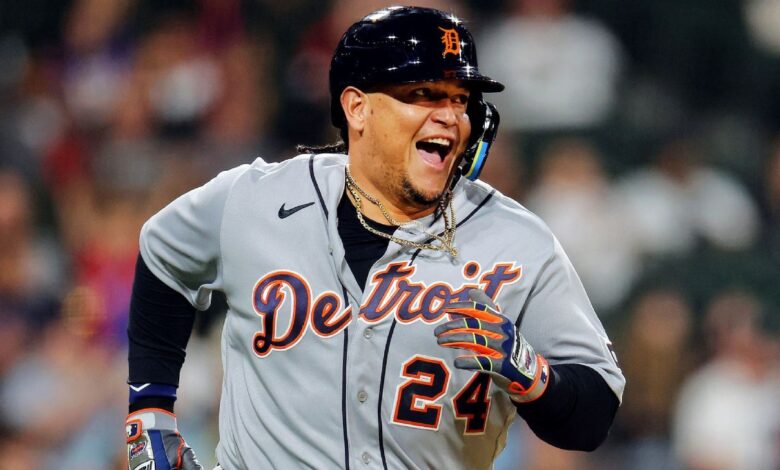
ON SEPT. 2, on one of those chilly Chicago evenings when it’s obvious that autumn is near, Miguel Cabrera played the best game he’s had in almost two years. In the top of the first inning, he doubled and passed George Brett for 17th on the all-time hit list. Cabrera then singled in the fourth, sixth and eighth inning. The last one was a chopper up the middle. The ball bounced off home plate, then over the pitcher’s mound toward White Sox second baseman Lenyn Sosa. Cabrera jogged, certain he’d be out; his game was never about running out infield hits.
Even as a kid, Cabrera wasn’t fast. When he was 17, barely learning English and playing for the Florida Complex League Marlins, a scouting report from his then-manager Kevin Boles noted the lone deficiency in Cabrera’s game was foot speed. “Has a chance to be a great player,” Boles wrote in his scouting report. “May develop into a huge offensive force.”
As Cabrera jogged on this September evening, 23 years later, the ball went past Sosa and the infield. Cabrera picked up his pace and made it safe to first base. Cabrera stood there, and the crowd — both Tigers and White Sox fans — clapped and cheered. One fan waved a Venezuelan flag. Another held a sign that read, “Bye #24 Miggy, thanks 4 the memories!!!”
Cabrera, an all-timer now relegated to a part-time role, mumbled something to himself, standing there on first base, breathing out his mouth in this otherwise forgettable late-season game between two teams with no playoff aspirations. Maybe it was a thank you. Or perhaps a few reaffirming words after thinking he’d finally found his rhythm at the tail end of his 21st and final season. Finding that or any semblance of his old self had been a constant search.
He then looked to the visitor’s dugout at Guaranteed Rate Field and walked off first, replaced by a pinch runner. And just like that, the moment was over. For the 49th time in his career he got four hits in a game, and it might be his last real moment of greatness on a baseball field.
“I’m telling you, Cabrera was one of those guys,” Boles said of the future Hall of Famer he once managed. “It didn’t matter who worked with him, nobody could screw this one up. It didn’t matter if anybody ever talked to him, he was going to be a star. That’s just how special he was.”
After that game, Cabrera wouldn’t play for another three days. Whatever rhythm he might have found that night in Chicago got lost while he sat and watched the Tigers play without him. But for that night, if only for that one night, his swing was there. Except for a few extra pounds and creases on his face, he looked like the younger version of himself.
A flashback of who he once was, in a season he hoped would go much different.
“IT WAS 1998” Louie Eljaua said of the first time he met Cabrera.
Back then, Eljaua was the Coordinator of Latin American Scouting for the Florida Marlins (he’s now the VP of International Scouting for the Chicago Cubs). For months, his scouts in Venezuela had told him there was a kid he had to see, a shortstop who looked like a seasoned pro when he swung the bat. He came from a baseball-playing family: His mother and three aunts played softball; an uncle, José Torres, played in Liga Paralela de Béisbol — a developmental professional league — and in the St. Louis Cardinals’ minor league system.
Eljaua took a plane from Miami to Caracas, Venezuela, then drove two hours southwest to the Maracay neighborhood of La Pedrera. On a clear and sunny afternoon, Eljaua stood on an unkept, dirt baseball field full of rocks. He’d flown across the Caribbean Sea to see a 15-year-old everyone called Miguelito, and the kid still wasn’t at the field.
“He’s running a little late,” Gregoria, Miguelito’s mom, told him. The Cabreras lived next to the baseball field. So close that, when Miguelito was younger, he’d sneak away to that dusty baseball field instead of doing his chores.
“He just got off from school,” Gregoria continued. “He had an exam to take.”
“No problem,” Eljaua answered.
Some 15 minutes later, a tall and slender boy jumped over a 6-foot-high concrete fence in the outfield.
“Is that him?” Eljaua asked Miguel Garcia, one of his Venezuelan scouts.
“Yes,” Garcia answered.
Eljaua was impressed with how easily Miguelito jumped the wall. From that distance, he also looked like a grown man: He was 6-foot-1, with a big head, something the neighborhood kids teased him about, joking it was the size of a train. It wasn’t until Miguelito walked closer that Eljaua saw how truly young he was.
“If you looked at his face, he could have been nine or 10 years old,” Eljaua remembered.
Miguelito shook hands with everyone, making eye contact while apologizing for running late. Then he started swinging his bat. He took about 10 or 12 or 15 swings before Eljaua asked him how he felt.
“Hey, you want to take a break?”
“No,” Miguelito answered. “I’m just getting warmed up.”
“You are?” Eljaua asked. “Okay.”
Miguelito swung some more, first hitting hard line drives, peppering them all over the field, then pulling the ball. “Okay, I’m loose now,” Miguelito said. That’s when he started hitting balls out of the field, above surrounding houses and their clotheslines and mango trees.
“Holy s—,” Eljaua thought to himself. “I think I found him.”
“Him” was the kind of player scouts dream about, who can change a franchise, who make scouts question themselves, wondering if what they’re seeing is real. In the case of Miguelito, Eljaua immediately knew that even if he never hit a home run, he would turn out to be a great hitter. Of course, Miguelito also did have power. And that day when Eljaua first saw him, Cabrera swung his bat so well and hit the ball so long, the workout came to a sudden end.
“We had to stop,” Eljaua remembers. “We were running out of balls.”
Convinced he was their player, Eljaua visited Venezuela more often, scheduling trips around games he played. The more they saw him play, the more they wanted him. One year later, shortly after Miguelito turned 16, the Marlins signed him to a $1.8 million contract.
A quarter century later, Eljaua still remembers that day better than all the other scouting trips he’s made during this 30-year career, that day the kid jumped the fence and swung like that.
“Just imagine the same swing he’s had throughout his career,” Eljaua says. “Except, I’m watching it from a 15-year-old.”
ON A MARCH afternoon inside Miami’s LoanDepot Park, a few weeks before his last MLB season begins, Cabrera leans on a bat, almost using it like a cane. His 12-year-old son, Christopher, stands beside him. The Venezuelan flag flies on the jumbotron near center field, and Cabrera and his son watch the Venezuelan national team practice and prepare for the World Baseball Classic.
“This type of event is enjoyed more by sons and family,” Cabrera says.
Cabrera occasionally points and says a few words to Christopher that only the two of them can hear. Christopher also plays baseball, but Cabrera doesn’t talk much about that. He doesn’t want to add to whatever pressure already comes from being the son of one of the greatest Latino baseball players ever. “More than anything he’s my son and I’m his father,” Cabrera says. “Our relationship isn’t built on baseball.”
Since 2006, Cabrera has played in all five World Baseball Classics, the only player to do so. This will be the last time he participates, and his role will be very different. As Omar López, Venezuela’s manager, puts it: “Miguel’s role isn’t what he’s going to do, but what he’s already done.” López has known Cabrera since he was 16, back when he played in Venezuela’s professional league, and was a prodigy in a baseball-obsessed country. Miggy, as everyone calls him now, went on to become the best player his country has ever produced, and so he is on the team as a figurehead and for leadership, to mostly watch and maybe get a few at-bats on a team built around All-Stars Luis Arráez, José Altuve and Ronald Acuña Jr.
After his teammates have taken their swings, he steps in the batting cage. After four or five cuts, Cabrera steps out and returns to watch the team practice, leaning on his bat again.
The following day, in Venezuela’s win over the Dominican Republic, Cabrera doesn’t play. The day after that, against Puerto Rico, Cabrera does play. In his first at-bat, as the fans in the stands bang on drums and blow on horns, he strikes out swinging. In his second at-bat, on the fifth pitch, Cabrera lines a single to center field, his lone hit for the entire tournament.
“Dale, todavia batea ese caballo,” a voice yells from the stand. That horse can still hit.
IN JUNE, THE Tigers go on an 1-11 stretch that extinguishes the small hope that 2023 would end their eight-year postseason drought. Cabrera isn’t playing much, even if, at $32 million, he’s the highest-paid player on the team. Tigers’ manager A.J. Hinch says he’d like to play him more, but the pitching matchup must be right, and it also depends on how Cabrera’s feeling that day.
His right knee has been hurting for years. In 2019, he consulted with four surgeons, including James Andrews. Each one gave Cabrera the same diagnosis: His knee didn’t need surgery since, more than anything, it’s just what happens when the body gets old. Cabrera tried easing the pain by losing weight. He reported to 2020 spring training about 25 pounds lighter, hoping to return to first base after being the designated hitter. And he did, for a bit, until he strained his calf or felt tightness in his back, or his knee felt sore again, then it was back to DH.
“Knee injuries, those are the toughest,” future Hall of Famer Albert Pujols says. If there’s anyone who understands what Cabrera is going through in his last season, it’s Pujols. He first made the majors in 2001, two years before Cabrera did, and retired in 2022. He and Cabrera are two of the three players in MLB history to eclipse 500 home runs, 600 doubles and 3,000 hits; Hank Aaron is the third. “He’s one of the best hitter’s that I have seen,” Pujols says of Cabrera.
Pujols also struggled physically during the end of his career. “As a hitter, when you have any problem with your knee, those are really concerning,” Pujols says. In his case, he put more pressure on his good knee to protect the one that hurt. Then the good knee started to bother him too. During his last season, his body hurt so much he had to get talked out of walking away right before the All-Star break, when he was batting about 80 points below his career average and had just six home runs. In the second half, he raised his average by 50 points and hit 18 home runs. He says he just needed to find his rhythm; he believed he could still play, even at 42.
There’s a thin line between confidence and delusion. Star players often blur the two. Generational talents sometimes can’t tell the difference at all. For someone like Cabrera, acknowledging any slippage is antithetical to how he sees himself, even if he’s hit below .300 for seven straight seasons. Another hot streak is one at bat away. He just needs more swings.
“When I get the opportunity, I’ll be ready,” Cabrera says.
At the 59-game mark, he’s played in 31 of them, batting .202, with no home runs. On those days he doesn’t play, he takes batting practice early, before anyone else.
Hoping the swing is still there.
“IT’S SOMETHING THAT’S been planned,” Cabrera says of his retirement.
He’s sitting in front of his locker in the Tigers’ clubhouse. Here, like out there, he’s impossible to ignore, his laugh and voice and jokes everywhere in the clubhouse. When an attendant comes to take away the boxes of new shoes stacked in front of his locker, Cabrera starts to wrestle him.
His final season hasn’t been easy. Cabrera will play two games, sometimes three, then rest a few. That cycle has created what feels like an unsolvable puzzle: He’s sure that if he had more at bats, he’d find a better rhythm and get more hits; if he was hitting better, he’d get more at-bats.
“It’s been difficult adapting to not playing every day,” Cabrera says.
He doesn’t talk often to the media. He sits there, in front of his locker in the corner of the clubhouse, and looks annoyed. Sometimes, instead of saying anything, he purses his lips, wrinkles his brow and shakes his head. The longest answer he gives explains why he isn’t talking much.
“I don’t like the same questions that reporters always ask,” he says. “Like you, you come and tell me, ‘I want to talk about where you started.’ My career is over 20 years long and I’ve talked about where I started.”
Cabrera also doesn’t want to talk about the political and socioeconomic issues plaguing Venezuela, where his home in Maracay has been especially hard hit. In the heavy silence, the sounds of ping pong being played a few feet away feels louder.
“Miggy, you playing today?” someone asks him about 45 minutes later as he stands on the field, near the Tigers’ dugout in Comerica Park. Cabrera answers with a head shake. He then takes photos and signs a few autographs for some young fans on the field.
“Hey, we have the same shoes,” Cabrera tells one of them; they’re both wearing the black Air Jordan 11’s. After autographs and photographs, Cabrera shakes the young fan’s hand and waves him goodbye. He then walks away, to get ready for a game he won’t play.
THE FOLLOWING DAY, Cabrera returns to the lineup. June 10 is Miggy Milestones Bobblehead Day. During the past few years, the largest crowds at Comerica Park appear whenever Cabrera is nearing a milestone or when there’ll be a celebration for him. This game is no different. This season, Tigers home games have an average attendance of about 20,600, one of the league’s lowest. The attendance for this game is 31,607.
Cabrera hit two doubles and with each one, the numbers in left field — above a sign that says “Miggy Milestones” — changes, from 3,108, to 3,109, to 3,110. To the left of those numbers is 507, his career home runs. That number still hasn’t changed all season. Finally, on June 14, 65 games into the 2023 season, Cabrera hits his first homer. A fastball that lands a few feet back of the first row of section 149 in left field, not far from where the “Miggy Milestone” numbers hang. As he rounds third, he smiles and screams to the Tigers’ dugout.
Every Tiger who hits a home run celebrates by carrying a pair of CCM hockey gloves, a hockey stick and putting on a Detroit Red Wings helmet. Cabrera does the same, and as he struts into the dugout, his teammates — some so young they wore diapers when Cabrera was a rookie — celebrate with him. They pat him on the shoulder and back. They smile. His knee might be hurting, but at that moment, his swing once again feels right.
CABRERA SITS BEHIND a table inside a conference room in Miami’s LoanDepot Park, almost five months since he watched his Venezuelan teammates prepare for the WBC. The morning before, a Thursday in late July, an email said there’d be a press conference the next day, and that it’d be the only time Cabrera would talk with the media. “Only” was written in bold. This is his last press conference in Miami, where he started his career, got called “The Kid,” by former manager Jack McKeon, then got traded during the 2007 winter meetings even though he didn’t want to leave.
Cabrera talks for about 15 minutes, about how special Miami is to him, about winning the World Series here as a rookie in 2003, about how he has two major regrets: He wishes he’d won a WBC for Venezuela and a World Series for Detroit. He says he now sympathizes with part-time players because it’s difficult to not play every day. He’s grateful for the reception he’s gotten during his final season. It’s been so positive it sometimes leaves him confused, because they are cheering for a player who is no longer great.
“I didn’t expect to get applause after striking out,” Cabrera says. “People don’t think I still want to hit, that I still want to compete, that I still want to take the field and win.” He then smiles and even laughs, admitting it feels good to get cheered even when he strikes out.
The following day, in an on-field ceremony, the three mayors of Miami-Dade County, Miami and Doral — where 35% of residents were born in Venezuela — proclaim July 29 as Miguel Cabrera Day. It was part of the Miami’s Venezuelan Heritage Day celebration. Almost 33,000 fans — the highest attendance the Marlins have had since 2017 — clapped and cheered one last time for their countryman.
“It’s something expected,” Patricia Andrade says of Cabrera’s final year, “but that doesn’t keep it from being sad.” She’s from Venezuela but has been in the United States for 36 years. Since January 2016, she’s run a program in Miami, Raíces Venezolanas, that helps recent migrants from her home nation. She’s also a baseball fanatic who was thrilled when the Venezuelan kid came to play for her local team. She bought his jersey and wore it often to Marlins games, where she’d waved a Venezuelan flag and yelled Cabrera’s name. She mourned when he got traded away. And now she celebrates him even though she doesn’t want to see him leave for good.
“It’s a very demanding career and he deserves his rest,” Andrade says of Cabrera. “But that doesn’t keep it from hurting. We’re selfish. Humans are selfish, we don’t want him to leave.”
HERE’S A PARTIAL list of what teams gave Cabrera to honor his career during the last season he played.
In April, during the first full week of the season, the Astros gave Cabrera a black cowboy hat and a bottle from Dusty Baker’s wine label. The next week, the Blue Jays gave him framed photographs of the game, two years before, when he hit his 500th career home run against them.
In May, the Washington Nationals presented Cabrera with a rocking chair, a base signed by their players and a United States flag folded in a triangle. The St. Louis Cardinals gave Cabrera a framed photograph of him crossing home plate after hitting his 400th home run against them.
June is when the Texas Rangers gave Cabrera a horse saddle. The Phillies gave him a piece of the out-of-town scoreboard at Citizens Bank Park. Along with that, a much more personal gift. Dave Dombrowski, the Phillies’ President of Baseball Operations, gave him a framed photo collage of his family with Cabrera.
“I wanted to give him something from me and my family, because he knew them all,” Dombrowski says. He was Marlins general manager when the team signed him at 16, and later was Detroit’s GM when the Tigers shocked everyone, including themselves, by trading for Cabrera. For a few days until the deal got made, Dombrowski and his team locked themselves in a hotel room, afraid a rival team would find out and disrupt their plan to get Cabrera, who he calls, “the best positional player that I’ve been around.”
In July, the Mariners gave Cabrera a green colored Starbucks apron, a gift basket full of coffee and a $7,500 donation for his Miggy Foundation that helps young athletes and their communities. The next series, the Royals gave him framed photographs of the night, 11 years before, when he won the Triple Crown while playing against them.
In August, the Pirates gave Cabrera a painting of himself standing on the Roberto Clemente Bridge, next to the bridge’s namesake and two other Pirates greats, Honus Wagner and Paul Waner. All of them immortalized in the piece of art, presented to Cabrera as he stood close to Jim Leyland, his former manager in Detroit.
Leyland, now 78, says Barry Bonds — who he managed in Pittsburgh — might be the best player ever, and Cabrera is right there with him. “Two thousand twelve was the greatest individual season I’ve ever seen,” Leyland says of Cabrera’s Triple Crown season, the only one of the past 56 years. He earned the first of two consecutive MVPs that year. Leyland still watches Cabrera play; they remain close, even if they don’t talk as often as they once did. He knows Cabrera is a proud man. “The time has come for Miggy to probably hang it up,” Leyland says. “He knows that.”
In early September, the White Sox gave Cabrera a bench made of bases, baseballs and bats. It’s also when the Tigers started a hotline so fans could call or text MIGGY24 to (313) 471-2424 and leave a message thanking and congratulating Cabrera on his career.
“Hello, this is Miguel Cabrera,” the hotline’s recorded message said. “I’m sorry I missed your call. Leave the message after the beep.”
ON SEPT. 29, the Tigers will play the Guardians in a three-game series that in any other year would just be a formality before the long season ends. But this year, those three days will be called “Gracias Miggy.” The weekend-long celebration will include a drone show, a small museum of Cabrera’s accomplishments, music and fireworks. There will be drinks and food from El Rey de las Arepas, Cabrera’s favorite Venezuelan restaurant in the city.
“Cabrera is loved in Detroit,” says Joe Swierlik, who was named the Tigers’ biggest fan in a 2020 contest sponsored by Comerica Park. “For many, he’s the closest monumental player we will ever see.” Swierlik is 38, about a year too young to have been alive the last time Detroit won a World Series. For most of his childhood, he watched the Tigers play in what he calls, “one of the most brutal periods to watch.” Then, for most of his adult life, he watched Cabrera play for his favorite team. He remembers how close they got to winning it all in 2012. As a fan, that’s the one thing he regrets.
“Hall of Fame career,” he says of Cabrera, “but to not get a World Series with the Tigers, that’s the hardest part to bear.”
In recent Detroit history, Steve Yzerman, Justin Verlander, Barry Sanders and Calvin Johnson stand out as the city’s other superstars. The last two left during their prime, within range of setting league records. Cabrera’s career is different; he didn’t leave much behind. The man who stands as one of this generation’s greatest hitter hasn’t played anything close to a full season since 2016. And now, in the coming days, he’ll have the last of his over 10,000 at-bats.
When he’s asked what comes next, he says, simply: “I don’t like to get too far ahead.” As he talks, you can still see parts of his youth in his eyes, the baby face, the hints of his mischievous smile. “I like to live day to day,” Cabrera continues. “I try to control what I can control today, and tomorrow, we’ll see what we can do.”
Though he’s mentioned it in the past, right now he’s certain he doesn’t want to coach. He says it’s too hard because when you play, you have some control over the game, but when you sit on the bench and watch, what little control you had is gone. Watching so often from the dugout this past year has only reinforced his thoughts.
Cabrera says he’s prepared himself for life after baseball, but still: He just wishes he could’ve played more in his last season. With more at bats, he’s certain he would’ve found his rhythm and hit more balls. He’s sure of it, because, when he was young, and people still called him Miguelito, he did that better than just about anyone else.
But now his body hurts. He spent his final season searching for the rhythm of his swing. He tried to find it before Detroit’s cold hit again. And now, as September gives way to October, he’ll try to find it again, one last time.

